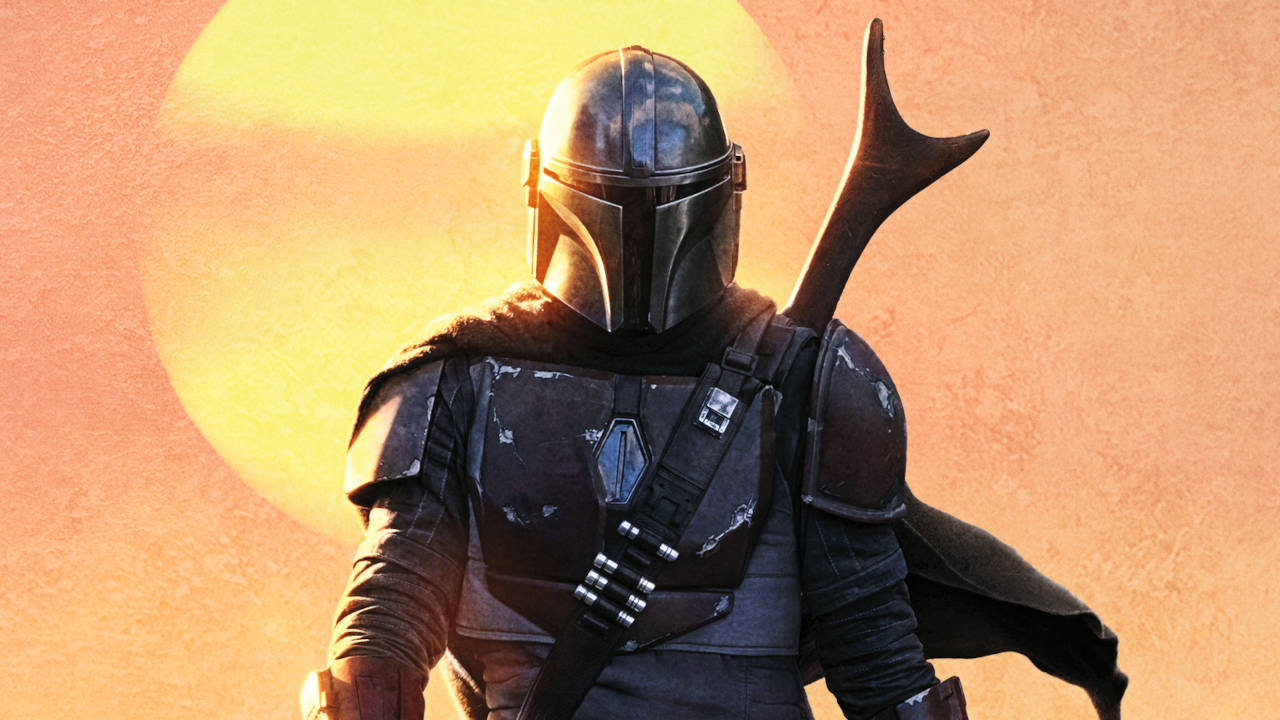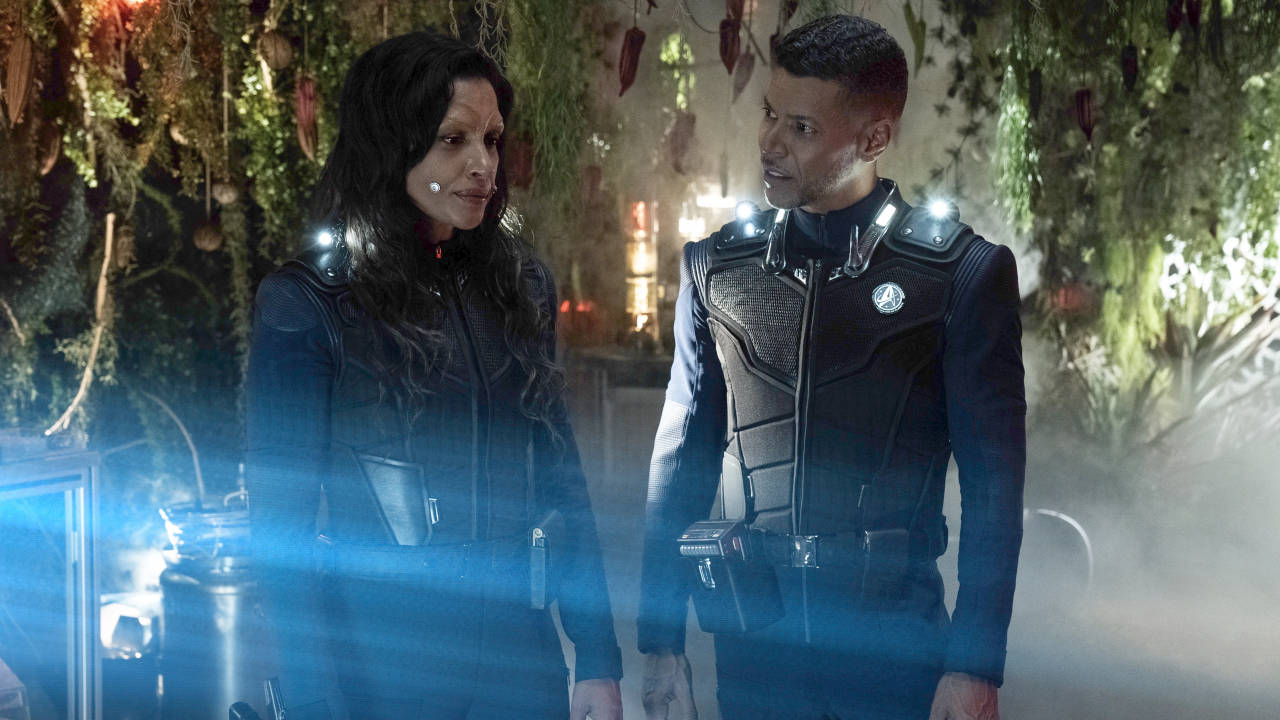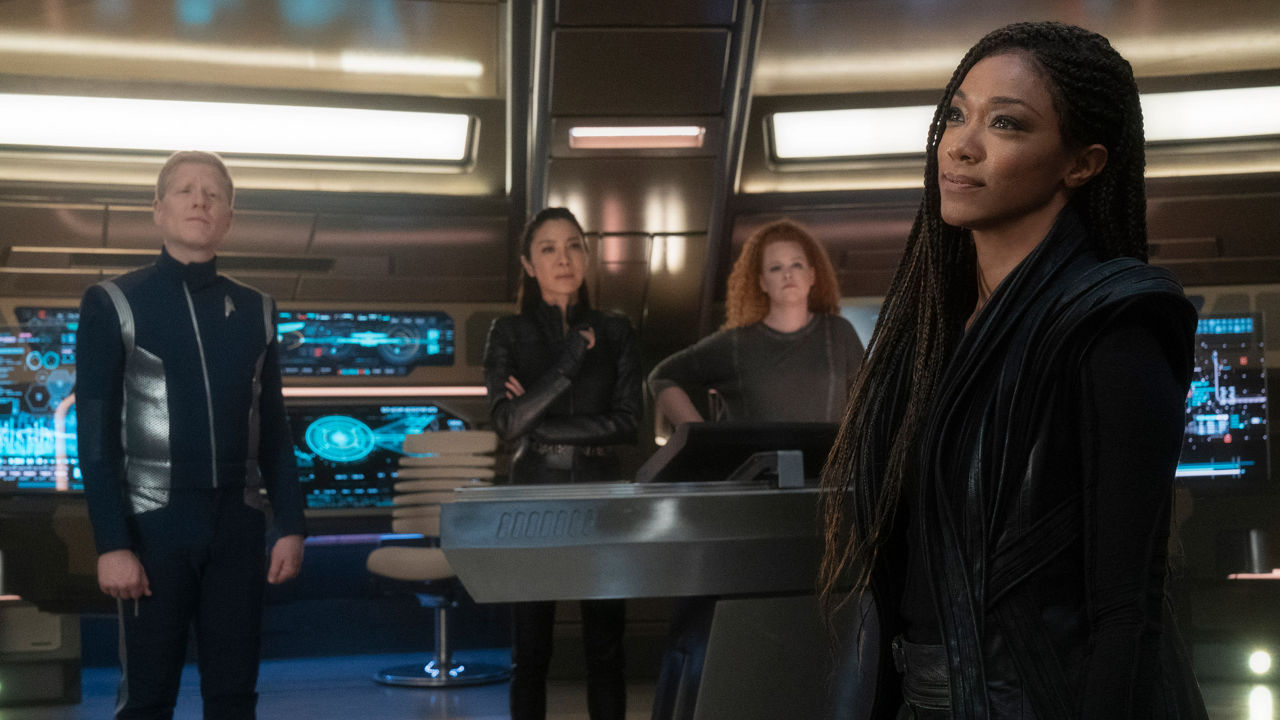Article Content
Mandalorian meets Jedi in an outstanding episode

On Corvus, Jedi Ahsoka Tano (Rosario Dawson) arrives at the gates of an occupied city and demands an audience with the Magistrate, Morgan Elsbeth (Diana Lee Inosanto), with whom she has unsettled business. It’s a standoff, with the guards unable to kill or capture Tano but holding her at bay by threatening the city’s innocent hostages.
In between two nights of this standoff, Djarin arrives at the city and is hired by Elsbeth to assassinate Tano. His reward: a staff made of pure beskar. Of course, since Djarin has come here specifically to bring the Child to Tano, Elsbeth has no idea that she has basically set in motion her own defeat.
“The Jedi” is a masterpiece of cinematic style, mood, and photography, executed in the spirit of an Akira Kurosawa samurai epic, with nods in the editing, cinematography, production design, and the amazing atmosphere that suffuses every scene. I’m no expert on East Asian cinema, and I can’t call out individual shots and match them to their source films, but Dave Filoni has taken an episode of pop-culture television and brought an artistry to it that’s cumulatively effective in how it evokes an overall aesthetic, whether it’s with the composition of particular shots (for example, the long-shot side view establishing Tano about to face off with the Elsbeth on the bridge), or the smoke from the charred forest that hangs in the air in every scene.
‘Scavengers’: Go rogue or go home

Booker’s vessel — minus Book, but not his cat — appears at Starfleet Headquarters. A recording left by Book details his discovery of a "black box" from a starship destroyed in the Burn, found in the slave labor regions run by the Orion/Andorian syndicate, where Book has gone missing and may now be held captive. Such a black box could be a key piece of evidence in understanding how, and perhaps from where, the Burn originated. This is a mystery very much on Burnham’s mind, and she wants to undertake a rescue mission to find her missing friend as well as this black box of possible evidence.
The catch: Admiral Vance needs Discovery on standby for something more urgent to the greater good of Starfleet, so Saru can’t sanction a mission for one man (who, by the way, isn’t even a member of Discovery‘s crew), even if it might shed light on the Burn. So Burnham decides to go rogue and disobey a direct order to rescue Book. She recruits Georgiou ("You had me at unsanctioned mission") to help her.
Let’s talk about ‘The Mandalorian’

I’ve opened up a new section on Jammer’s Reviews devoted to The Mandalorian. I’m watching the show, I’m enjoying it a lot, and many of you are too. So why not have a place to talk about it?
Now, before you get too excited, I am not doing full-length reviews of this series. This is something of an experiment. Basically, I will open up a page for each episode when it’s released on Disney+. Then, at some point during the week, I will add a brief review. Repeat: These will not be detailed, full-length reviews in my typical format. There also won’t be big photos on the home page for each episode, nor blog posts here to prompt the RSS feed for the three of you still following my content that way. (That’s an activity which is probably more a waste of my time as it is, and merely an excuse to populate my mostly dormant blog with cross-posts.) (Read more…)
Discovery returns to the fold

There’s a lot to unpack in the dense and ambitious "Die Trying," which is easily the best episode of the third season so far and among Discovery‘s best outings, and possibly its most balanced to date. This show tries to do a lot of things, and it ends up doing most of them very well. There’s promising stuff here.
If “Forget Me Not” was a good example of Discovery dialing it down and acting like classic Trek, "Die Trying" is more in line with Discovery‘s own true DNA. But it has figured out how to balance the formula and blend its more modern sensibilities with the classic ones. It does this in a story where Discovery reaches the 32nd-century joint Starfleet/Federation headquarters where they meet Admiral Charles Vance (Oded Fehr), who debriefs them on some current happenings, but has numerous questions for the crew of such an old ship.
Gone but not forgotten

"Forget Me Not" is a refreshingly, unusually quiet and introspective hour of Discovery that feels like it’s from a previous generation of Star Trek. It’s among the quietest and most character-driven episodes of the series. It’s perhaps not the most riveting episode of all time and it employs plenty of mystical alien mumbo-jumbo, but it’s very nicely done and sincere, and it benefits from a final revelation that’s truly intriguing — building on a concept previously explored by adding just a slight little spin on things that’s rather ingenious.
The episode takes us to the Trill homeworld, to see if they can help Adira — the only known successful example of a human joined with a Trill symbiont (I guess Riker in "The Host" doesn’t count because it was temporary) — recover the Tal symbiont’s memories, which are blocked from her. (These memories include those of Admiral Senna Tal, who may know where to find what remains of the Federation.) Indeed, Adira can’t remember how she even came to be joined with the symbiont in the first place.
There’s no place like home

"People of Earth" is an effective mix of emotions and well-paced starship-standoff action, and provides our first glimpse at what a familiar Federation locale — specifically Earth — looks like in the post-Federation 32nd century. It’s our first real attempt at world building within this third season. This is a step up from the first two outings, which felt like generic space westerns in terms of their storytelling. (Although, as space westerns go, they had nothing on this past weekend’s season premiere of The Mandalorian.)
This series wears its emotions on its sleeve, and Burnham’s reunion with the Discovery crew is milked for all the feels, and pretty effectively. Tilly reflects in a pretty good scene that having traveled forward in time means everyone they knew is now long dead; it’s good to see the story slow down to acknowledge what it means to be displaced permanently from your time. New Braided Chillax Burnham seems all about letting the past go, and indeed it at first seems questionable whether she will even rejoin the crew. She has a nice reunion with Saru, where kind words are exchanged and she relinquishes any ambitions she ever had to be captain. Like I said last week, Martin-Green’s performance is notably lighter with Burnham having now spent a year in this century as a courier. Even Tilly mentions the new air.
A fistful of dilithium

I’m so glad to learn the aesthetics of 19th-century saloons, complete with batwing doors, have survived into the 32nd century. That’s some staying power. And that bad guys come strolling into such saloons with an imposing swagger as the camera makes a point to show us their jangling boots before showing us their faces.
There’s a scene midway through "Far From Home" that screams out: Hey look! Space cowboys in a space western! At the risk of setting up an expectation where I will make one Andromeda reference per episode this season (don’t count on it), I couldn’t help but think of that series’ "Last Call at the Broken Hammer," which also had a futuristic saloon with batwing doors, albeit infinitely worse production values.
Star Trek arrives in the 32nd century

Few, if any, slate-clearing series reboots have been as extreme (or contrived) as Discovery‘s jump forward in time 931 years to the year 3188 in order to (deep breath) hide a cache of indestructible, self-aware data from an evil artificial intelligence whose acquisition of that data would mean certain galactic Armageddon. I mean, that is something. The writers either wanted to get as far away from the show’s original pre-TOS setting as possible, or they had some new things they wanted to explore in the very-far-flung future of the Trekkian universe. They clearly weren’t interested in a mild or middle-ground shakeup.
The brand-spankin’ new thing they apparently want to do is an official Star Trek remake of Gene Roddenberry’s Andromeda. (The premise of Andromeda’s post-Commonwealth fall was itself simply a way of telling a post-Federation story outside the actual Trek universe.) The news of the Federation’s fall is gradually revealed in "That Hope Is You, Part 1" an episode that arrives at the season’s new mission statement (let’s re-establish the Federation!) by the end of the episode but, on the whole, is a pretty unremarkable but okay hour. As slow-burn establishing material goes, this is average.
Jammer’s plans for ‘Star Trek: Lower Decks’
Star Trek: Lower Decks, the latest entry into the ever-expanding CBS All Access Star Trek Extended Universe™ (the trailer is embedded above, if you somehow haven’t already seen it), premieres on Aug. 6. I will not be reviewing it. I will not be watching it, either, because I don’t intend to re-up my CBS All Access subscription at this time (which I canceled immediately after Picard‘s first season concluded) just to consume yet another Star Trek product, in this case one I have no interest in.
‘Picard’ reveals what the season is actually about

So, now that I see the full picture, I realize what season one of Star Trek: Picard is actually about.
It’s not about the Romulan refugee crisis. It’s not about the reclamation project going on in the derelict Borg cube. It’s not about the Zhat Vash or the Tal Shiar or undercover Romulan commodores, or the attack on Mars or the synth ban. It’s not about catching up with Hugh or Riker or Troi or Seven, or about Soji learning her true identity, or Raffi drinking and vaping all the time, or Rios and his holograms, or everyone trying to track down Bruce Maddox only so that Agnes could kill him, or about the robot apocalypse.
Oh, sure, it was sometimes very much about all those things. But, ultimately, it wasn’t about them. Thematically, emotionally, spiritually — nah. I see now that all those things were basically very elaborate and prolonged MacGuffins. The means to an end. They don’t matter, except to fill 10 episodes of screen time, to distract us, to misdirect us, and hopefully entertain us along the way (with variable degrees of success).
No, what this season of Star Trek: Picard is actually about is Picard saying goodbye to Data.
